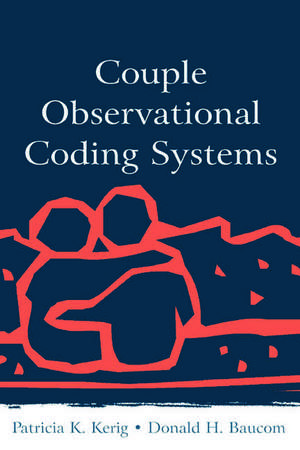Couple Observational Coding Systems
Editat de Patricia K. Kerig, Donald H. Baucomen Limba Engleză Hardback – 27 mai 2004
The first three chapters present overviews of conceptual and methodological issues in the study of couple processes. The remaining chapters describe contributions to the field by 16 teams of researchers. Each chapter provides information about the conceptual underpinnings and structure of the coding system developed by the authors and evidence for its psychometric properties.
Couple Observational Coding Systems will be of interest to researchers studying couple interactions as well as clinicians who work with couples.
| Toate formatele și edițiile | Preț | Express |
|---|---|---|
| Paperback (1) | 485.07 lei 6-8 săpt. | |
| Taylor & Francis – 7 mai 2015 | 485.07 lei 6-8 săpt. | |
| Hardback (1) | 952.94 lei 6-8 săpt. | |
| Taylor & Francis – 27 mai 2004 | 952.94 lei 6-8 săpt. |
Preț: 952.94 lei
Preț vechi: 1162.12 lei
-18% Nou
Puncte Express: 1429
Preț estimativ în valută:
182.34€ • 190.38$ • 150.91£
182.34€ • 190.38$ • 150.91£
Carte tipărită la comandă
Livrare economică 05-19 aprilie
Preluare comenzi: 021 569.72.76
Specificații
ISBN-13: 9780805843576
ISBN-10: 0805843574
Pagini: 388
Dimensiuni: 152 x 229 x 27 mm
Greutate: 0.66 kg
Ediția:New.
Editura: Taylor & Francis
Colecția Routledge
Locul publicării:Oxford, United Kingdom
ISBN-10: 0805843574
Pagini: 388
Dimensiuni: 152 x 229 x 27 mm
Greutate: 0.66 kg
Ediția:New.
Editura: Taylor & Francis
Colecția Routledge
Locul publicării:Oxford, United Kingdom
Public țintă
ProfessionalCuprins
Contents: Preface. Part I: Conceptual and Methodological Issues. D.H. Baucom, P.K. Kerig, Coding Couples' Interactions: Introduction and Overview. R.L. Weiss, R.E. Heyman, Couples Observational Research: An Impertinent, Critical Overview. F.J. Floyd, C.H. Rogers, Methodological Guidelines for Conducting Observations of Couples. S.L. Sayers, K. McGrath, Data Analytic Strategies for Couple Observational Coding Systems. Part II: Problem-Solving and Communication. R.E. Heyman, Rapid Marital Interaction Coding System (RMICS). W.A. Griffin, S.M. Greene, A. Decker-Haas, The MICSEASE: An Observational Coding System for Capturing Social Processes. G.H. Kline, D. Julien, B. Baucom, S. Hartman, K. Gilbert, T. Gonzalez, H.J. Markman, The Interactional Dimensions Coding System (ICDS): A Global System for Couple Interactions. K. Hahlweg, Kategoriensystem für Partnerschaftliche Interaktion (KPI): Interactional Coding System (ICS). F.J. Floyd, Communication Skills Test (CST) Observational System for Couples' Problem-Solving Skills. M. Sevier, L.E. Simpson, A. Christensen, Observational Coding of Demand-Withdraw Interactions in Couples. N.M. Malik, K.M. Lindahl, System for Coding Interactions in Dyads. Part III: Affect and Intimacy. A.F. Shapiro, J.M. Gottman, The Specific Affect Coding System. J.L. Driver, J.M. Gottman, Turning Toward Versus Turning Away: A Coding System of Daily Interactions. A.A. Tabares, J.L. Driver, J.M. Gottman, Repair Attempts Observational Coding System: Measuring De-Escalation of Negative Affect During Marital Conflict. M. Dorian, J.V. Cordova, Coding Intimacy in Couples' Interactions. M.S. Schulz, R.J. Waldinger, Looking in the Mirror: Participant Observation of Affect Using Video Recall in Couple Interactions. Part IV: Information Processing. D. Vivian, J. Langhinrichsen-Rohling, R.E. Heyaman, The Thematic Coding of Dyadic Interactions: Observing the Context of Couple Conflict. L.J. Sullivan, D.H. Baucom, The Relationship Schema Coding System: Coding the Behavioral Manifestations of Relationship Thinking. Part V: Social Support. J.A. Suhr, C.E. Cutrona, K.K. Krebs, S.L. Jensen, The Social Support Behavior Code. L.A. Pasch, K.W. Harris, K.T. Sullivan, T.N. Bradbury, The Social Support Interaction Coding System.
Notă biografică
Patricia K. Kerig, Donald H. Baucom
Descriere
A companion volume to Family Observational Coding Systems, this book moves from the triad to the dyad and provides a showcase for significant developments in the coding of intimate couple interactions. The first three chapters present overviews of
















